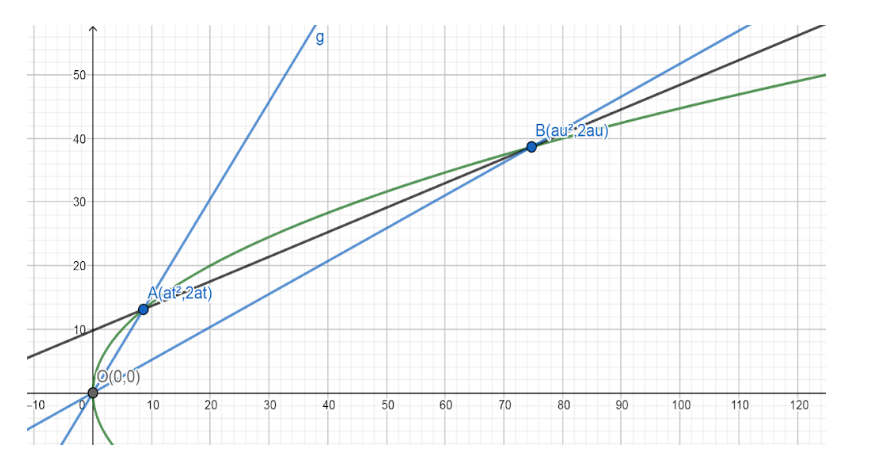Question
Question: Find the locus of the middle points of chords of the parabola which subtend a constant angle \[\alph...
Find the locus of the middle points of chords of the parabola which subtend a constant angle α at the vertex.
Solution
Hint: Since vertex is at origin the lines passing through it are of form y=mx. Take two general points on parabola and make lines passing through them and the origin. The angle between these two lines should be α.
Complete step-by-step answer:

Consider the above picture. A(at2,2at)andB(au2,2au)are two variable points on the standard parabola y2=4ax with parameters t and u respectively.
We have been given that ∠AOB is constant i.e. equal to α.
We can also write α as the angle between line AO and line BO.
These are lines passing through origin and can be written as y=mx where m is the slope of the line.
So let,
AO be y=t2x
BO be y=u2x
(Slope of lines passing through origin are just ratio of y coordinate and x coordinate of any point on the line)
So,
tanα=1+t2×u2t2−u2
tanα=1+ut4ut2u−ut2t
tanα=utut+ut4ut2u−ut2t
tanα=utut+4ut2u−2t
tanα=ut+42(u−t)...(i)
Now let point (h,k)lie on our locus. Since they lie on the locus it is the midpoint of our variable chord AB.
So using the midpoint formula which is,
Xmid=2x1+x2
ymid= 2y1+y2
We write,
h=\left\\{ \dfrac{\left( x~coordinate~of~A \right)+\left( x~coordinate~of~B \right)}{2} \right\\}
k=\left\\{ \dfrac{\left( y~coordinate~of~A \right)+\left( y~coordinate~of~B \right)}{2} \right\\}
And,
h=\left\\{ \dfrac{\left( \text{a}{{\text{t}}^{2}} \right)+\left( a{{u}^{2}} \right)}{2} \right\\}
2h=(at2)+(au2)
\dfrac{2h}{a}=\left\\{ {{\text{t}}^{2}}+{{u}^{2}} \right\\}...(ii)
k=\left\\{ \dfrac{\left( 2at \right)+\left( 2au \right)}{2} \right\\}
k=(at)+(au)
\dfrac{k}{a}=\left\\{ t+u \right\\}...(iii)
So our next task in finding the locus is eliminating the variables from the above equations.
Squaring equation(iii)and subtracting it from (ii) i.e. (iii)2−(ii)
Which gives,
{{\left( \dfrac{k}{a} \right)}^{2}}-\dfrac{2h}{a}={{\left( t+u \right)}^{2}}-\left\\{ {{\text{t}}^{2}}+{{u}^{2}} \right\\}
{{\left( \dfrac{k}{a} \right)}^{2}}-\dfrac{2h}{a}=\left( {{t}^{2}}+{{u}^{2}}+2ut \right)-\left\\{ {{\text{t}}^{2}}+{{u}^{2}} \right\\}
(ak)2−a2h=2ut...(iv)
Squaring equation(iii)and subtracting it from 2×(iv) i.e. (iii)2−2(iv)
Which gives,
{{\left\\{ \dfrac{k}{a} \right\\}}^{2}}-2\left\\{ {{\left( \dfrac{k}{a} \right)}^{2}}-\dfrac{2h}{a} \right\\}={{\left( t+u \right)}^{2}}-2\left( 2ut \right)
(ak)2−2(ak)2+2a2h=(t2+u2+2ut)−4ut
−(ak)2+a4h=(t2+u2−2ut)
a4h−(ak)2=(u−t)2
a4h−(ak)2=u−t...(v)
Substituting equations (iv)and (v)in (i)
tanα4+2(ak)2−a2h=2a4h−(ak)2
{{\left( \tan \alpha \right)}^{2}}{{\left\\{ 4+\dfrac{{{\left( \dfrac{k}{a} \right)}^{2}}-\dfrac{2h}{a}}{2} \right\\}}^{2}}=4\left( \dfrac{4h}{a}-{{\left( \dfrac{k}{a} \right)}^{2}} \right)
Now since (h,k)are general points on our locus we can replace h by x and k byy.
{{\left( \tan \alpha \right)}^{2}}{{\left\\{ 4+\dfrac{{{\left( \dfrac{y}{a} \right)}^{2}}-\dfrac{2x}{a}}{2} \right\\}}^{2}}=4\left( \dfrac{4x}{a}-{{\left( \dfrac{y}{a} \right)}^{2}} \right)
This is the required locus.
Note: Students have to think carefully while deciding which is the variable before eliminating. In this question students might eliminate a which will give them the wrong answer. Also they may use their different techniques to eliminate the variable from the equations. Also, if they feel it is redundant to use (h,k)first and then replace it as (x,y) they may use (x,y)from the start as well.
